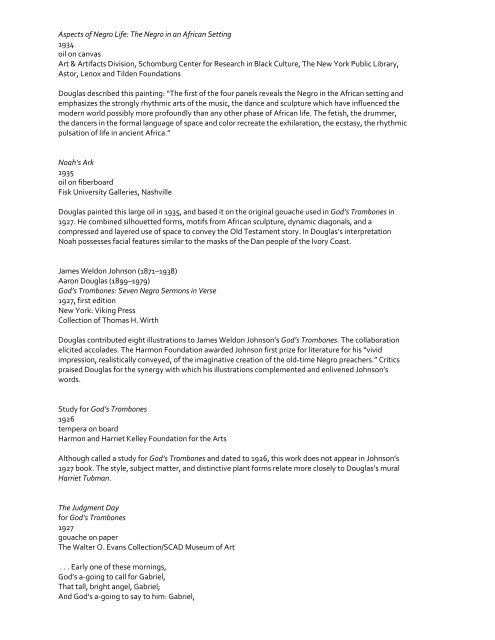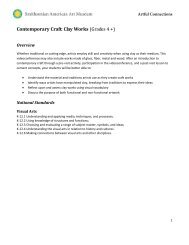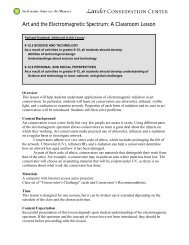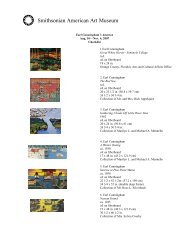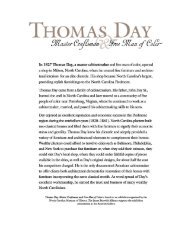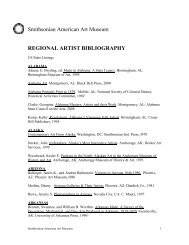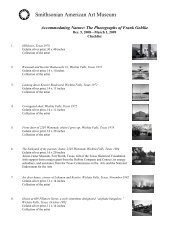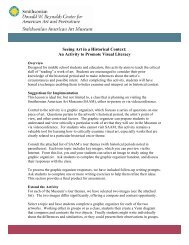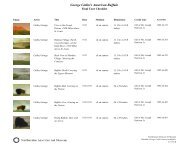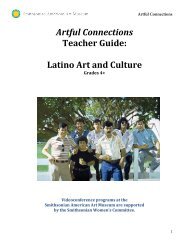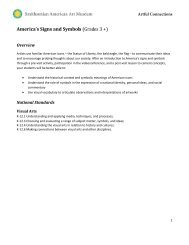Smithsonian American Art Museum Wall Text & Extended Labels
Smithsonian American Art Museum Wall Text & Extended Labels
Smithsonian American Art Museum Wall Text & Extended Labels
Create successful ePaper yourself
Turn your PDF publications into a flip-book with our unique Google optimized e-Paper software.
Aspects of Negro Life: The Negro in an African Setting<br />
1934<br />
oil on canvas<br />
<strong>Art</strong> & <strong>Art</strong>ifacts Division, Schomburg Center for Research in Black Culture, The New York Public Library,<br />
Astor, Lenox and Tilden Foundations<br />
Douglas described this painting: “The first of the four panels reveals the Negro in the African setting and<br />
emphasizes the strongly rhythmic arts of the music, the dance and sculpture which have influenced the<br />
modern world possibly more profoundly than any other phase of African life. The fetish, the drummer,<br />
the dancers in the formal language of space and color recreate the exhilaration, the ecstasy, the rhythmic<br />
pulsation of life in ancient Africa.”<br />
Noah’s Ark<br />
1935<br />
oil on fiberboard<br />
Fisk University Galleries, Nashville<br />
Douglas painted this large oil in 1935, and based it on the original gouache used in God’s Trombones in<br />
1927. He combined silhouetted forms, motifs from African sculpture, dynamic diagonals, and a<br />
compressed and layered use of space to convey the Old Testament story. In Douglas’s interpretation<br />
Noah possesses facial features similar to the masks of the Dan people of the Ivory Coast.<br />
James Weldon Johnson (1871–1938)<br />
Aaron Douglas (1899–1979)<br />
God’s Trombones: Seven Negro Sermons in Verse<br />
1927, first edition<br />
New York: Viking Press<br />
Collection of Thomas H. Wirth<br />
Douglas contributed eight illustrations to James Weldon Johnson’s God’s Trombones. The collaboration<br />
elicited accolades. The Harmon Foundation awarded Johnson first prize for literature for his “vivid<br />
impression, realistically conveyed, of the imaginative creation of the old‐time Negro preachers.” Critics<br />
praised Douglas for the synergy with which his illustrations complemented and enlivened Johnson’s<br />
words.<br />
Study for God’s Trombones<br />
1926<br />
tempera on board<br />
Harmon and Harriet Kelley Foundation for the <strong>Art</strong>s<br />
Although called a study for God’s Trombones and dated to 1926, this work does not appear in Johnson’s<br />
1927 book. The style, subject matter, and distinctive plant forms relate more closely to Douglas’s mural<br />
Harriet Tubman.<br />
The Judgment Day<br />
for God’s Trombones<br />
1927<br />
gouache on paper<br />
The Walter O. Evans Collection/SCAD <strong>Museum</strong> of <strong>Art</strong><br />
. . . Early one of these mornings,<br />
God’s a‐going to call for Gabriel,<br />
That tall, bright angel, Gabriel;<br />
And God’s a‐going to say to him: Gabriel,


